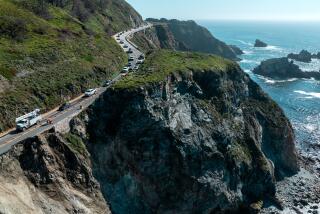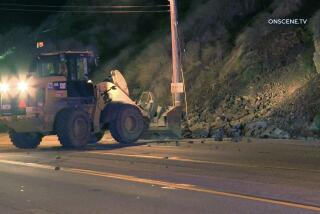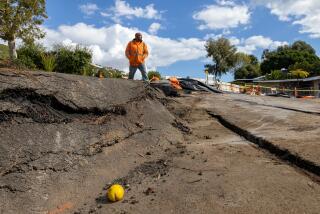Washington slide scene: Debris 10 feet high, then mud twice as high
OSO, Wash. -- Under a rain-gray sky, a fire chief led me and three other journalists into the woods to a spot overlooking the massive mudslide here.
The day was wet and cold, with a chill wind.
We traveled mostly on foot, hiking up a muddy trail for an expansive view of the debris field below. It was Thursday morning, five days since Saturday’s catastrophe, and from such a vantage point on the southern side of the Stillaguamish River we could see the breadth of the destruction.
PHOTOS: Mudslide in Washington state
First, though, we had taken in the scene from ground level after driving to within about 400 meters of the slide. We stopped in the middle of Highway 530, which connects the towns of Arlington and Darrington but is now blocked by a wall of mud.
Ahead was a pile of debris about 10 feet high and, beyond that, a pile of gray-brown mud about twice as high. The highway was lined with ambulances and trucks, and at the foot of the debris pile two earthmovers rumbled along the muck, picking at the wreckage.
Near the edge of the mudslide, workers mixed with a cluster of civilians under an orange tent. Officials have been trying to provide families access to this area so they can see it for themselves.
Steve Mason, battalion chief for Snohomish County Fire District 1, said family members were brought to the site Wednesday and Thursday.
“There’s a lot of grieving going on,” he said.
He pointed up the mountain to where the slide started. Fog shrouded the wounded hillside, which was shorn of trees.
“We were supposed to fly in and have a meeting this morning, but the fog came in,” Mason said before describing the mudslide’s path.
“It all kind of rolled down this corridor here,” he said, sweeping his hand down across the site. “It was a washboard effect.”
As he was speaking, half a dozen men in fatigues drove past us on an all-terrain vehicle, headed toward the slide to help in the rescue and recovery effort. The National Guard has been responding, along with other agencies.
Mason led us up a dirt path -- one that was created after the mudslide -- and over crushed grass through shoulder-high brambles.
We were on the west side of the mudslide, he said.
“On the other side, that’s where all the water is backing up. It’s turning all of that into a lake. So the guys have to get through that before they can get to the dirt,” he said.
Workers there have been using boats and hovercraft to cross the lake and search the rubble, he said.
After hiking up the steep, rain-slicked trail, we arrived at a clearing. The landscape spread out before us in shades of gray: metal gray sky, mud-caked trees and muddy debris. Alders and a few pine trees ringed a flattened area covered by a jumble of downed trees, planks and unrecognizable remains of houses.
The few spots of color included a white propane tank floating in the muck.
Muddy water pooled throughout the swampy sea of gray mud. From where I stood, I couldn’t smell anything except maybe the rain. The only sounds were the beeping and clanking of equipment, and a lone bird.
About 15 workers in yellow fluorescent vests stood out against the sea of gray, picking their way through the mud. A firefighter made his way along downed tree trunks. An orange piece of construction equipment, a digger with a bucket, worked at the center of the scene, lifting debris.
“The slide came down here and spread out here,” Mason said, gesturing down the hill. “The slide comes around the corner and spreads out that way. You have homes that are now islands.”
Workers walked through the woods near us, planning an emergency road. Mason pointed to cables already installed by a local utility company so that Darrington doesn’t get cut off.
Mason said forensic digging teams were also at work excavating homes, or what remained of them.
He explained that the teams cut into a house, back off to check the perimeter, then use construction equipment that “takes a small bite” of the debris and finally “look through that very carefully.”
First responders have been sorting through debris, creating “slash” piles of natural materials and “rubble” or “debris” piles of material that’s hazardous and needs to be removed.
“There’s millions of cubic feet of stuff out there. It’s a slow process,” Mason said. “They’re in waist-deep mud at some times. They’re very dirty and exhausted. It’s very hard to be methodical in this situation.”
He pointed down.
“Those piles are people’s residences, so they’re very methodically going through them.”
Of the homes, he said, “Some of them look like they were put in a blender and dropped -- it’s just a big pile. We want to make sure we’re going through this inch by inch. There’s a lot of hand digging.”
As he spoke, a handler led a search dog, a black Lab, away from the scene. Another dog and handler arrived soon afterward.
Mason said crews have created a network of paths into the wreckage, with excavators working on platforms fashioned from plywood.
“We’re building a little network out here,” he said. “The problem is, it continues to rain.”
Another concern: the risk of more mudslides.
Mason pointed out workers atop the mudslide, tiny figures in the distance. Crews go by the top of the slide daily “to put in instrumentation and make sure the workers are safe.”
He said they also covered several tree trunks with foil so that they can see from the bottom of the hill whether the trees are still standing.
“That needs to be monitored because there could always be more,” he said.
We left soon after noon, following the same wooded, muddy trail back to the impassible highway, the wall of mud, the unchanged list of the missing and day six of uncertainty.
More to Read
Start your day right
Sign up for Essential California for news, features and recommendations from the L.A. Times and beyond in your inbox six days a week.
You may occasionally receive promotional content from the Los Angeles Times.







